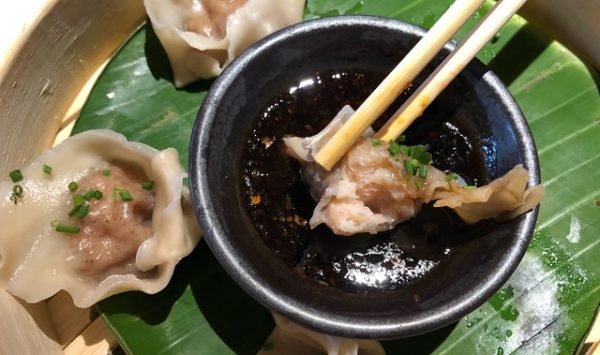About 15 years ago I had a concept for a restaurant. The menu would be an exotic journey through all the great cuisines of Asia. I was never wealthy enough, talented enough or foolish enough to make it a reality. But somebody else was. Somebody else had very much the same idea and that someone was one of the world’s most daring and successful restauranteurs.

Jean-Georges Vongerichten is best known as a chef but it’s his skills as a businessman that has led to his name being on twelve restaurants in New York, another ten in other parts of the U.S., as well as eateries in Singapore, Indonesia, London, the Bahamas, Japan and Brazil. In 2004, Jean-Georges Vongerichten opened Spice Market in New York. In 2019, Spice Market opened in San Miguel de Allende.
Vongerichten’s name is no longer assiciated with the brand but many of the dishes that originated on the New York menu still exist on the one in San Miguel.

Spice Market occupies one corner of the hotel Live Aqua, the best corner if you consider its unobstructed view from the terrace to the West at sunset. A subtle pair of teak doors open to an exotic world that could be five thousand miles away. The tables have more than adequate space around them. The stoneware takes you to a table somewhere in Southeast Asia. The tasteful objets d’art in the recesses of the walls at each end of the room are beautifully backlit. The overhead lighting is big and bold but the soft, warm light it casts is small in lumens. Spice Market may be the most attractive restaurant in all of San Miguel.

Considering the amount of prep work and hands-on cooking required for almost every item, the size of the menu is enormous. Think of any commercially popular dish from China, Japan, India, Malaysia, Korea, Thailand, the Philippines or Vietnam and, chances are, you’ll find it on Spice Market’s menu.

There are 20 choices on the front, divided between small plates, dim sum and robato. There are 18 more on the back, divided between soups and salads, classics, curries and wok. Now romantic lighting does not make romantic typefaces easy to read but with a little squinting, we soon placed at least half of the items on the front page on our must try list.

The dishes are perfect for sharing and, so far, Don Day’s Wife and I have tried nine of them. Some were big hits. Others were not quite there.

Your meal at Spice Market begins with a couple of very sophisticated touches. First, a well-dressed, well-mannered, well-informed and well-trained server who seems genuinely excited about everything on the menu takes your order. Second, a facecloth scented with ginger arrives in a bamboo steamer to help you get rid of that San Miguel dust you might have brought in with you.

It’s followed by another nice touch, a complimentary basket of poppadom, the crispy, seasoned bread made from lentil flour sided with a bowl of tomato, basil and chile jam. The textures and tastes are superb.
Don Day’s Wife and I spend six months each year in San Miguel de Allende and, during that time, we spend six months each year mourning the loss of our weekly dim sum feast. The dim sum section of Spice Market’s menu was a definite starting point. I had hoped for the shrimp dumplings the Cantonese call ha gau or the pork dumplings they call siu mai but there were a couple of good alternatives.

The shrimp and mushroom wontons had a tasty filling and tangy sesame chile sauce but the dough was a little heavy and chewy; still worth a second order though.
The second noodle dish was more Japanese than Chinese. The chicken filling was moist with some gentle spicing. The gyoza was advertised as crispy but seemed more steamed than fried; still enjoyable though. The sauce, listed as a truffle vinaigrette, was short on flavor but the sesame chile that came with the wontons was a good substitute.
Though you wouldn’t find them in any dim sum restaurant I’ve ever been in, the other two items in the dim sum section of Spice Market’s were also on our must try list.

The chicken samosas were on the original edition of Spice Market’s New York menu and it’s no wonder they have such staying power. It’s extremely difficult to make a thin and crispy samosa pastry.

Spice Market’s chef de cuisine Alejandro Santana nails it.

Dipped in the cool comfort of the India meets Mexico cilantro yogourt, they get even better.

Plaudits to chef Alex again for his Taiwanese bao. The steamed bun that wraps around the pork belly, the healthy (or perhaps it’s unhealthy) portion of meat and the imaginative addition of a slice of Asian pear now has me ranking Spice Market’s bao over the same dish at San Miguel restaurants, Atrio and Marsala.

Salt and pepper calamari was a dish I was introduced to at dim sum restaurant Ton Kiang in San Francisco back in the nineties. I’ve rarely ever seen it since so it was a joy to find it as one of Spice Market’s small plates. The batter was light and fluffy and, as there was next to no greasy taste, it was obviously deep fried in a clean oil at an appropriate temperature. Pickled chiles as an accompaniment was a first for me and definitely worth a second order.

There were two minor disappointments in our choices. When I order a curry, I use the traffic light guidelines where red, yellow or green usually (but not always) mean hot, medium or mild.

The red curry duck, another original from the New York menu, not only had next to no fire but little more than pineapple and coconut flavors. It needed some cumin, coriander or tumeric…some chiles to add that missing heat. Though Chef Alex told me they only use leg that the restaurant confits in house, the duck meat tended to be mushy.

The presentation of the ginger fried rice is pure theatre. The dish arrives at the table steaming and sizzling in a speckled black and white bowl. The server then continues the showbiz by tossing it with the egg that’s shining like sunshine on top. Unfortunately, the taste of ginger is there but little else, not even the nuttiness you get from frying rice. The dish is crying for a protein or something else that will waken up the tastebuds. If you’re a vegetarian, I would go for it; if you’re a carnivore, I’d give it a pass.

Chicken wings are an excellent menu item for comparison purposes and Spice Market’s are one of the town’s best. There’s lots of moist, fall-apart meat and the Korean-style sauce has that perfect balance of heat and sweet.
About the only thing people may not like about the wings…and it’s something that they may not like about quite a few other things on the menu…is the price. At $250 for five wings, they’re about twice the price of any other wings in town. $320 for the five wontons or $275 for the three samosas are big numbers as well.

“I love that street food has come into such elegant surroundings”, said Don Day’s Wife, “but it’s priced like we’re on New York streets not San Miguel.”
So is Spice Market worth the extra money you’ll spend? I think it depends on what you want from the experience. If I was a married guy with three young kids, I’d probably say no. If I was a single guy who wanted a sophisticated and romantic rendezvous, I’d definitely say yes. And if I was the real me, a seventy something guy with a craving for Asian specialties that I couldn’t find anywhere else in my middle of Mexico town, I’d say yes as well. At least, once in a while.
The original Spice Market in New York lasted until 2016, a victim mostly of dramatically rising rents in its meatpacking district home. The next two, however, in Atlanta and Istanbul had even shorter lives. After almost 20 years, there are, currently, only two other Spice Markets, in Qatar and in Punta de Mita on the west coast of Mexico.
So how long will Spice Market San Miguel last? If it can survive solely on the deep pockets of those people staying at Live Aqua, probably a long, long time. If it needs a steady flow of the shallower pocketed ex-pats in this town, it’s very hard to say. I’m hoping it lasts at least as long I do. There is still a long list of dishes on our must try list.

Spice Market is located in the Live Aqua Urban Resort, Calzada de la Presa 85, in San Miguel de Allende, Mexico.


Nice article. You answered the question whether Jean !Georges is still associated with Spice Market.
Would you mind giving your readers some sample prices of the dishes on the menu
There are photos of the menus and prices though I admit they’re difficult to read (hard to read in person as well). Dishes average about $350 and you’ll need four or five to share between two.
Just spent two weeks in Viet Nam (February) and sought in vain in your article some/any
items that are made and eaten there, not just for tourists
South East Asia?
.
A friend and I ate lunch there a couple of days ago. It was excellent. Only one dish disappointed, and we informed the staff of that. It’s definitely pricey. Our lunch for two was over 2000 pesos + tip, with no alcoholic beverages. I will return.